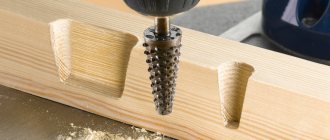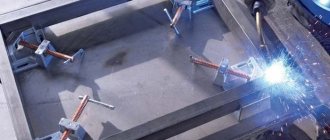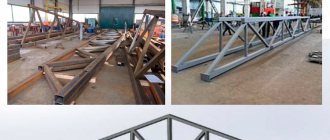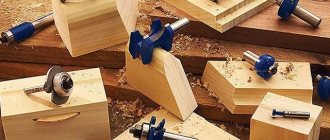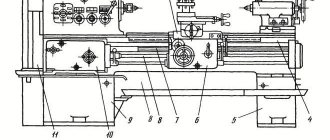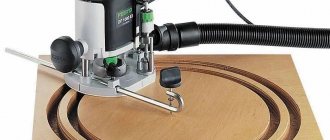23.03.2020
- Design and operating principle
- Classification of cutters: by what parameters
- Types of cutters for metal
- Classification of cutters according to some characteristics
- Nuances of choice
- Storage and operation rules
- Wide range of milling machine capabilities
During milling metalworking, it is important what type of metal cutter the master has chosen. In the article we will talk about the numerous varieties and features of their use - both a beginner and a professional will need this for repetition.
Milling cutter for a manual wood router - what is it, device, purpose
A milling cutter is the main tool with which wood is processed. The scope of application, purpose, and result depend on its technical characteristics. Despite the fact that there are many varieties of it in terms of shape and features of the cutting edge, materials and other parameters, they are all united by the general principle of the device and the presence of standard parts:
- The cutting area, also called the head or working part. It can have different geometry, composition and blade design.
- Shank - serves as a support for the previous element. With its help, the tool is clamped in the machine chuck, and torque is also transmitted to the main part.
- Additional component. It is located on the very edge of the instrument - opposite the tail section. This could be a support bearing, locking couplings, screws, washers, calibration bushings and other devices. Their task is to simplify or expand the functionality of the cutter, for example, to arrange the cutting segments in the required sequence or to process the workpiece according to a given pattern.
Diagram of an end mill with designation of characteristics Source infradom.ru
Depending on the scope and purpose, modern wood cutters for a manual router allow you to solve the following types of problems:
- Forming edges. It is used when it is necessary to create parts of workpieces that are combined into one structure using a tongue-and-groove connection.
- Creation of cut-outs for installation of fittings.
- Production of decorative forms, cuttings, configurations.
Advice! Certain types of work require your own set of cutting tools. Therefore, before selecting specific types of cutters, it is necessary to determine what the nature, type and volume of wood processing work performed with their help will be.
Application
Cylindrical cutters are designed for installation on a horizontal milling machine. Used for roughing and semi-finishing of straight planes of parts located parallel to the tool axis. The cutter teeth have a straight or helical shape. Tools with helical teeth are convenient for processing narrow areas of the workpiece. To reduce axial forces, a dual tool is used, with different inclinations of the cutting surfaces. This allows you to equalize axial forces during the processing of metal parts.
Cylindrical cutters are one of the main types of equipment, widely used in mechanical engineering for the production of complex parts for machines and equipment. The tool material is high-speed steel with carbide working inserts, which can significantly extend its service life.
Classification of cutters by shank size, type of design and cutting part
Cutting tools for a manual milling machine are classified primarily according to the following three criteria:
- Tail dimensions.
- Type of construction – prefabricated, replaceable blades, monolithic, attachment/set-on.
- Material and method of sharpening the cutting edge.
Let's look at these parameters in more detail.
Set of cutters for woodworking Source instrumentgid.ru
Tail dimensions
In the characteristics of the tail section, the unit of diameter is of paramount importance. The designation must coincide with a similar parameter of the collet - the place where the cutter is mounted in the machine. As a rule, there are only two standards for this value:
- Millimeter. The most common sizes are 6, 8 and 12 mm.
- Inch. There are two main types - half and quarter inches, denoted - ½ and ¼, respectively.
When comparing two measurement systems, it turns out that products with similar diameters differ only by a small amount in size. Thus, 6 mm and ¼ or 6.35 mm cutters and 12 mm and ½ or 12.7 mm cutters look almost the same - however, the holder of a hand router is not adapted to securely hold any type of tool, like a drill chuck.
Therefore, a 12 mm cutter loaded into a ½-inch collet will not sit securely in the chuck and can easily fly out during processing. Likewise, if you load a ½-inch tool into a 12-mm holder, it may jam so much that you will have to come and repair the machine later.
The packaging indicates the size and other main parameters of the cutters Source goods.ru
The second important characteristic is the length of the shank. However, often when choosing the right tool in terms of shape, design, diameter and other parameters, it turns out that it is impossible to find one suitable for the processing conditions of the required length. In this case, special extension adapters come to the rescue.
It should also be remembered that such “helpers” should be used as a last resort and with caution. Since under loads, speeds and revolutions characteristic of modern machines, such a device will always have the property of a “weak link”.
Important! Metric and imperial cutting attachments are not interchangeable. And their use in this capacity can lead not only to damage to the workpiece or machine, but also risks injury to the operator.
See also: Catalog of companies that specialize in garden furniture and storage systems
Type of construction – prefabricated, replaceable blades, monolithic, attachment/set-on
According to the design features of wood cutters, there are 4 main types:
- Prefabricated. It is made by soldering, using refractory solders, the cutting edge to a monolithic base - the shank and the head. They are distinguished by simplicity and accessibility of production.
Example of a prefabricated cylindrical cutter Source atis-market.com
- With replaceable blades. The cutting edge is a separate element, fixed to the head with screws and which the user can replace or sharpen as necessary. Some products have up to 4 working surfaces - which significantly increases the working life of the tool.
- Monolithic. The cutting part is formed directly on the base itself - by analogy with a drill. The advantage is the minimal risk of blade tearing off. However, for prolonged use it must be periodically sharpened, which over time changes the original geometry, impairs performance and leads to the need for replacement.
- Mounted/set-on. The cutting head is connected to the shank in a movable manner. This allows you to change the distance between elements and their sequence for more varied processing of workpieces.
Recommendation! To gain experience and become familiar with processing techniques, a novice user only needs to purchase prefabricated cutters. For the more experienced and professional, kit tools are the best option.
Milling cutter with replaceable blades Source prostanki.com
Material and method of sharpening the cutting edge
The large number of revolutions and the resulting high temperature in the processing zone force tool developers to use the following 2 types of metal alloys as cutting edge materials for wood cutters for hand routers:
- Tool steel. It is marked - HSS. Designed for processing low-density wood at maximum speeds. Disadvantage: when it gets into a denser environment, the cutting edge instantly becomes dull. Therefore, it is not suitable for cutting chipboard, MDF and other similar materials.
- Carbide brazing. Designated - NM. Used for processing dense wood at medium and low speeds. Can also be used for finishing machining with high cutting edge quality. However, it is often impossible to achieve the ideal degree of smoothness when finishing with an average cutter of this type.
Frame cutters with carbide-tipped blades Source zubr-rus.ru
Is it possible to do it yourself?
Despite their apparent simplicity, the production of these products requires advanced, high-precision and high-tech equipment. The cutter should be:
- ideally balanced in weight so that there are no eccentric beats at high speeds;
- the profiles of the knives and their location must repeat each other with high accuracy, up to hundredths of a mm;
- cutting edges (knives) must be made of hard alloys, which can only be profiled and sharpened with an even more durable tool.
For these reasons, it is almost impossible to make a cutter yourself without equipment. The exception is simple straight knives on equipment with replaceable blades. In theory, you can cut the desired size from, for example, planer knives. But even here there are problems with balancing the weight and drilling holes for fastenings in solid metal.
In a home workshop you can sharpen some types of profiles. This is done from the back side of the cutting edge, since it is impossible to do this on a curved profile from the side of the tip, sharpened at an angle.
Sharpening is carried out with a flat diamond file. But it’s more effective on a sharpening machine, a thin or bowl-shaped wheel that fits into the niche of the cutter and reaches the surface to be sharpened.
Severe overheating during sharpening is unacceptable, as this will change the factory characteristics of hardening (heat treatment) of the metal. Sharpening is carried out until a small chamfer appears on the reverse side. Then the chamfer is carefully removed with zero-grit sandpaper, using light movements so as not to dull the tip.
Varieties by processing method
In order to choose the right wood cutter for a hand router, you need to have an idea of what types are used for specific types of work with workpieces. According to this characteristic, cutting tools are divided into 5 main types:
- End.
- Grooved.
- Edges.
- Combined.
- Curvy.
Let us analyze in detail the main features and nuances of using each of them.
End
Having a structure similar to a drill, an end mill, however, differs from it in that its working part extends over the entire area of the cutting edge. That is, wood is sampled with the entire head part. There are the following varieties:
- Profile.
- Spherical.
- Conical.
- Spiral.
- End
- Burr cutters (cutters).
Most end mills have a universal purpose. Thus, spiral varieties allow you to drill and select grooves, quarters, and process ends; profile varieties allow you to make grooves of complex geometry, create ornaments, trim, cutters allow you to finish surfaces, engrave, select special shapes of holes and grooves.
Wood end mill set Source fainaidea.com
Grooved
The very name of the groove cutter reveals the nature of its application - the choice of grooves. However, they differ in the following modifications:
- Fillet. A semicircular sample is formed.
- Conical. Creates a V-shaped groove and is also used for carving surfaces.
- Spiral. They have a structure similar to a drill, but with a larger working part.
- T-shaped. They are used to create grooves of the type where one part slides into another.
- Dovetail. Similar to the above modification - with the difference that the cross-section of the base has the shape of a trapezoid.
- Shaped. It has a wide variety of species. It is used both for making grooves and for processing ends.
- Straight or cylindrical. Create a rectangular groove.
- Combined. They are used to form interlocking joints - when assembling linings, panels, and panels.
Slot milling cutter with performance characteristics displayed Source static-sl.insales.ru
Recommendation! When choosing a specific type of wood cutter for a hand router, you need to have an idea of what they are like in terms of workmanship, thermal strength, connection of the cutting area with the tail part and solder material. When processing hardwood, a tool with weak soldering will soon lose its longitudinal stability and quickly fail.
Edge
An edge cutter is used to create an edge that is smooth and perpendicular to the plane of the workpiece. The following types are distinguished:
- Direct. Designed to create an end perpendicular to the upper plane.
- Moulded. Straight, arched, wavy edges are formed. Used for applying complex patterns. There are also double cutters with the ability to adjust the distance between the blades.
How to choose
The quality and durability of a cutter can only be determined through actual work. It is impossible to do this by inspection or other means before purchasing. If you need to buy a large set of different profiles for a significant amount, you can check the quality without lengthy work in the following way:
- buy one cutter from the selected manufacturer;
- the reverse side of the cutting edge is trial sharpened with an ordinary file with a fine notch;
- if sawdust is removed, the alloy is not strong enough. (Easy to sharpen, easy to dull).
It is not worth buying a large number of cutters of this quality. Carbide edges are sharpened only with abrasive wheels of sharpening machines or diamond needle files; a regular file will not take them.
Signs of a low-quality or dull cutter - the profile is not completely selected. The tool moves with force, the wood turns black and burns until smoke appears.
A brand's reputation can give an idea of quality. Most brands produce “mass consumer goods” for household use, but the quality is good enough to do the job required.
The cutters of the above brands - Bosch, Enkor, Fit, etc. - have average and sufficient quality for work.
Price is not always an indicator of quality. The fact is that the price depends not only on the expensive or cheap alloys used, the cost of the equipment, but also on the profile of the cutter. A complex profile of a larger size costs more than a simple one.
Good cutters are produced by German manufacturers. Quality guarantee if the product is not manufactured, for example, “in the PRC under control, etc.,” but specifically in Germany. Therefore, when searching in online stores, you should click on country-. The results will only include products manufactured in this country.
German cutters are perfectly balanced, do not create vibrations or beats at high speeds, process wood as cleanly as possible and retain their working qualities for a very long time without sharpening.
Video description
Video instructions for choosing wood cutters for a beginner:
The ends of the workpieces to be joined are given a specific profile using a specific type of cutter. They are then connected by locking into a single, durable structure. The procedure is performed without additional adjustment of the selected surfaces, since the complete tools are perfectly matched to each other.
Curvy
The figuere type cutters are intended for forming panels. Example - baseboards, furniture doors, decorative strips, etc. As a rule, the tool is quite massive, and therefore machines with a power of 1.6 kW or more are used to process workpieces with it. In this case, cutters are divided into three categories:
- Horizontal. Create a panel.
- Double-sided. A panel and tenon are formed.
- Vertical. Used for selecting the profile of skirting boards.
On a note! By itself, even a good hand router and correctly selected cutters for the type of wood processing do not guarantee the planned result. For quality work, you will need a set of suitable stops and templates.
Recommendations for use
The performance of the tool directly depends on the correct selection and adherence to processing technology, primarily on compliance with the speed limit. During operation, the cutter becomes dull - a wear area is formed on the back surface of the tooth with an ever-increasing width and, from the impact of chips, a hole is formed on the front surface.
During work, it is necessary to carefully monitor wear, sharpen in a timely manner and avoid connecting the hole and the rear platform. The latter leads to catastrophic wear of the tool and for restoration it will be necessary to remove a large layer of metal. Signs of wear include vibration, uneven cutting surfaces, and excessive wear on the cutter.
Cooling during the milling process will help significantly reduce wear and extend service life. This requires special coolants, some of which also act as lubricants. The choice of coolant depends on the type of milling and the workpiece material. The liquid supply must be carried out continuously (stream or mist) from the first seconds of operation.
Briefly about the main thing
The milling cutter is the main cutting tool of a manual milling machine. Among its main parts are:
- Cutting part.
- Shank.
- Additional components.
It is used for various roughing and finishing tasks in woodworking - cutting grooves, trimming, forming interlocking joints, cutting, decorative design, etc. Milling cutters for wood processing are classified primarily according to a number of parameters such as the diameter and length of the tail, the type of design, the material from which the cutting edge is made and the method of sharpening it.
In addition, according to the method of processing the material, they differ into end, edge, groove, combined and figured. Each modification has its own characteristics and nuances of application.
Ratings 0
Nuances of choice
On production sites, you usually don’t have to “guess” which actuator to use in a particular case. The technological map usually specifies both the material of the blank and the methods. When developing such documents, numerous factors are taken into account:
- geometric parameters;
- steel quality;
- sharpening angle;
- cutting characteristics (helical and straight cutters experience different loads and have different effects on the surface being processed);
- linear speed of meeting the cutting edge;
- attack dimensions;
- resistance to changes;
- temperature regime;
- cooling intensity;
- quality of the resulting products;
- sequence of application.
Let's assume that you want to do the processing yourself. If you do not delve into the intricacies of the process and use the tool in gentle modes, then all that remains is to select the appropriate capabilities for the required tasks. For example, for cutting, a disk of one thickness or another with a working edge on the outer radius is used. If it is necessary to accurately produce one of the lines of such a cut, then a similar gadget is used, but with two sharpened sides. Through grooves are made in a similar way (there is a place for entry and exit).
All motorists are familiar with the operation called “head grinding”. Its purpose is to form a plane on the part adjacent to the block. This is done with end cutting tools. Due to circular movements, characteristic spherical marks will be visible on the part.
For cavities, finger bits are used, as they can make cuts both end-on and side-on.
In a word, a special tool is selected for each technological action.
Figurine cutters
The tool is used in the manufacture of panels, namely for decorative processing of the edges of parts. All equipment has a thrust bearing fixed at the bottom. A cutter with a bearing can process not only rectangular workpieces, but also shaped ones. You should know that paneling tools have a diameter of 50 to 70 m, so in order to use them effectively, you must have a device with a power of at least 1500 W. For a household router, processing panels with this type of equipment will be an impossible task.
To make doors using a manual milling cutter (meaning kitchen facades), you will need to purchase a special set consisting of three elements.
The set contains the following facade cutters: one panel cutter and two accessories for furniture trim (profile-counter-profile).
Horizontal
Used for pre-treatment of panels. To form a tenon for insertion into the frame groove, additional processing of the edge will be required.
Vertical
Most often, vertical figurine cutters are used to make baseboards.
Horizontal double-sided
This type of equipment significantly simplifies the production process, since in one pass of the tool a connecting tenon and part of a panel of a certain configuration appears on the edge.
In addition to the above types of equipment, many craftsmen also use homemade cutters. They are usually standard plumbing drills, sharpened in a special way. You can learn how this is done at home from the video.
Edge cutters
In most cases, edge cutters have a thrust bearing. Thanks to it, it becomes possible to guide the tool along the template, processing the edges and edges of the workpiece.
Half-rod
The tool creates semicircular protrusions on the edges of workpieces.
If you use a half-rod cutter in combination with a molding or fillet cutter, you can make hinged joints. Half-rod tools are also used to produce round rods. In this case, the workpiece is processed on both sides.
Curly
These shaped cutters are also called multi-profile cutters. Depending on the tasks, the master can use part of the equipment profile or use it completely. In the second case, you will need to install the tool in a unit that has a power of at least 1600 W.
Fillet
Designed to give the workpiece ribs an internal radius or to make grooves with a circular cross-section.
Fillet cutters are equipped with one or two bearings, eliminating tool distortion.
Conical
Using cone cutters you can:
- chamfer the edge of the workpiece;
- decorate the edge of the tabletop;
- create an angular cut on the edges of the workpiece before gluing them (polygonal-shaped products can be obtained).
Also included in this category is an edge cutter with a blade angle of 45 degrees.
Folded
Used for cutting quarters and grooves of rectangular section. Thanks to the thrust bearing, the rebate cutter can be used on both straight and curved workpieces.
To adjust the groove depth, thrust bearings of different diameters are used.
The slotted disc cutter also falls into this category. With its help, a groove is cut in the workpiece for installing a T-shaped PVC edge.
Mouldings
Moulder cutters allow you to obtain an arched, straight, or shaped edge on a workpiece. Working with any part of the same equipment, you can:
- round the edge of the part;
- get a rebated edge;
- make a semi-rod protrusion;
- get edge with sponge;
- make decorative processing of the ribs, for example, making window frames.
You can also use molding cutters to create complex shaped ornaments on the edges and ends of a wooden part.
The equipment in this series can also be double, as shown in the following figure.
On a double cutter, the distance between the elements can be changed in accordance with the thickness of the workpiece. Thanks to two elements, the workpiece is processed in one pass, simultaneously on both sides.
Direct
A straight edge (overrunning or end) cutter is used for finishing the ends of a workpiece or creating an ideal 90 angle between the face of a part and its edge (end). The bearing can be installed at the top or bottom of the tool.
With the lower position of the bearing, the template is fixed under the workpiece, and with the upper position - above the workpiece.
In addition to the facing function, the equipment with the upper bearing can be used as a groove tool and cut a rectangular groove on the workpiece face, of course, using a template of a certain height. The diameter of the bearing is usually equal to the diameter of the tool, meaning it is flush with the cutting edge. But in some cases it is changed to a smaller or larger diameter in order to expand the capabilities of the equipment.
Milling cutter “corn”
The corn cutter is also an edging cutter. Its main purpose is to grind and align the edges of the workpiece according to the template. Thanks to the special arrangement of the knives (in a spiral), easy chip removal and smooth operation of the tool are ensured.




